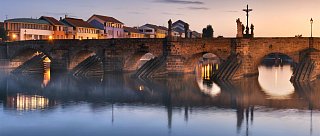Stone bridge
The oldest bridge in the Czech republic.
The Stone Bridge in Písek was built as a part of the Golden Route at the order of Ottokar II by the royal Písek-Zvíkov masons’ yard. It is a national cultural monument and a jewel of the town. Its construction was undoubtedly commenced in the second half of the 13th century; however, the first written account of the bridge comes from 1348, the time of Charles IV’s reign.
The construction of large stone bridges in the Middle Ages was rather rare due to the technical difficulties and extraordinary expense involved. The construction of the Stone Bridge in Písek was undoubtedly commenced in the second half of the 13thcentury during the reign of Ottokar II (1253-1278). This is evidenced by the stonemasons’ marks used on the bridge’s cuboids, identical to those found in other structures in Písek. The bridge and other important structures in the town (castle, main church, Dominican monastery, mayor’s house) were built by the royal “Písek-Zvíkov” masons’ yard. However, the first written account of the bridge falls into 1348, in the reign of Charles IV. At that time, the Golden Route connecting the Czech lands with Bavaria and Upper Austria led across the bridge. In the 16thcentury, as many as 1,600 pack animals crossed the bridge every week, bringing salt, expensive fabrics, southern fruits, wine, and spices to Bohemia and taking cereals, malt, honey, lard, and fish to Bavaria.
The bridge spans the river at a slight angle from the perpendicular. Semi-circular arches rest on wedge-shaped pillars with sharp axial blades directed against the flow of the river. There was a defensive tower at each end of the bridge. A flood in February, 1767, tore down the left-bank tower and damaged two arches, which were replaced with a single segmental arch. Due to structural weakness, the right-bank tower was demolished in 1821. Cuboids of granite from the Vltava area were used for the construction. The bridge is 109.75 m long, 6.25 m wide, and rises 6 m above the water level. There are five ice-aprons protecting the bridge against ice as well as floating trees.
In the 18thcentury, the bridge railing was decorated with Baroque statues of Calvary, St. Anthony of Padua, St. John of Nepomuk, and Madonna and Child with St. Anne. The sculptural group of Calvary is probably the work of the sculptor Jan Hammer of Čimelice. Authors of the other works remain unknown. The statue of St. Anthony of Padua was donated to the town in 1770 by Jan Filip Běšín of Běšiny, a former governor of the Prácheň region (the pedestal bears his coat of arms). In 1998, all the original statues were replaced with copies; the original works are exhibited in the Prácheň Museum in Písek.
Today the bridge is a national cultural monument and a jewel of the town.







